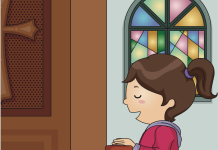
By Sr. Patricia M. McCormack, IHM, EdD
Technically, anomie is a sociological term but in general usage it means aimlessness, personal unrest, or a sense of alienation and anxiety that comes from a lack of purpose. Anomie can lead to depression. The most effective preventive or antidote is purposeful structure.
COVID-19 insinuated itself into our lives and seemingly overnight families find themselves quarantined; living more closely than usual; getting “testy” with other members; taking the definition of “couch potato” to a whole new level, and hearing the whine of “I’m bored. There’s nothing to do!”
Turn this crisis into a positive opportunity.
In all seasons – pre-COVID-19, during COVID-19, and post-COVID-19 – the self-esteem needed to function positively is rooted in purposeful structures, expectations, and industrious activity. In short, to avoid anomie (or to correct it) — pre-plan, organize, and schedule activities on a regular basis.
Throughout this pandemic, work to develop a schedule for wakeup, cleanup, meals, school work, leisure time, family time, chores, solitude, faith formation, and prayer time. Distinguish weekdays from weekends. Encourage your children to devote portions of the “extra free time” to expand their awareness of spiritual and faith formation topics.
Five Tips for Thriving through the Quarantine
- Create designated spaces.
Be creative in fashioning a prayer or reading space, perhaps with pillows and blankets and a reliable light source. Create a new schoolwork space; and even an outdoor play space.
For those blessed with garage space in their lives, Robin Oswold, mother of four, aunt to 13, and a Mimi to 13 grands advised:
“Clean out a space in your garage and pull the cars out – voilà!!! Kids can roller skate, jump rope, play hopscotch, draw with sidewalk chalk on the floor, do “messy” projects like watercolor painting and play dough. If you are worried about things they can get into, then hang sheets or fabric over tools or whatever. Even if it takes you are few hours to get your new playground ready, it’s worth it.”
- Expand Knowledge of Catholic Culture.
Focus on topics like the Commandments, Sacraments, Saints, rituals and devotional practices such as Stations of the Cross, the Rosary, or the formula for confession. Discover details of Catholic disciplines like holy days of obligation, fasting, and abstinence. And don’t forget the Mass, the Bible, Christian morality, Catholic traditions, and common prayers. Children especially enjoy stories and movies of the saints and Mary.
Some free digital resources include:
- Busted Halo web-video series like Sacraments 101 (Fr. Dave Dwyer, CSP)and Sacraments 201 (Fr. Steven Bell, CSP)
- You Don’t Know Jack … about Lent, Advent, Halloween, Valentines’ Day, New Year’s, and similar traditions (Fr. Jack Collins, CSP)
- Church videos and YouTube videos like Chiseled, Grace, and Triduum (Skit Guys @www.skitguys.com); and “Movies for Kids” at www.Formed.org.
- Design a Mary Marathon.
Include digital presentations of Mary’s various apparitions. Consider Fatima, Lourdes, Guadalupe, and the Miraculous Medal and the story of St. Catherine Labouré. You can spend a lot time learning about the Rosary and the meaning of its prayers and meditations. Try to learn how to make a Rosary. Begin to research the titles in the Litany of the Blessed Virgin Mary and the major Marian feast days. Find multicultural representations of Mary that reflect your family’s ethnic heritage or learn about others from around the world.
View free YouTube Movies on these apparitions of Mary. Additionally, be aware that the Augustine Institute (www.Formed.org) offers movies and presentations on these topics and many other topics of Catholic interest — on both adult and child levels. Normally a parish subscribes and publishes a code number to its parishioners. But during the COVID-19 crisis, Augustine Institute is offering a free 40-day subscription.
- Walk with the Saints.
Discover movies about these saints: Pope Paul VI, Pope John XXIII, Pope John Paul II, Josephine Bakhita, Teresa of Avila, Therese of Liseiux, Teresa of Calcutta, Faustina, Maria Goretti, John Henry Newman, André of Montreal, Anthony, Maria Goretti, Giuseppe Moscati, Edith Stein, Albert Chmielowski, Maximilian Kolbe, Pedro Poveda, Teresa of the Andes, Maria Soledad.
For each saint, help children and teens name the character traits that they (and you1) would like to add to your personality and faith development.
- Complete an “Around the Clock” Scavenger Hunt
This activity is best-suited to middle-school students.
Picture a typical clock that displays twelve hours. Beginning with one o’clock work your way around the clock by completing the task(s) assigned to the number. It may take several days to complete the challenge. Involve family help, if desired, or make it a contest between siblings and friends or a family activity.
This scavenger hunt is available as a free downloable PDF by clicking on this link:
AROUND THE CLOCK scavenger hunt. 2020
| “AROUND THE CLOCK” SCAVENGER HUNT
1. There is only ONE God but three divine persons. What prayer formula honors this belief?
|
| 2. There are TWO Testaments in the Bible – the Old [Hebrew Scriptures] and the New [Christian Scriptures]. How many books are in the Old Testament and what are their names? How many books are in the New Testament and what are their names?
|
| 3. There are THREE theological virtues. What are they? And what are the prayer formulas for each of them?
|
| 4. There are FOUR evangelists. A. What are their names? B. What are their artistic symbols? C. Which is the shortest Gospel? D. Which is the longest Gospel?
|
| 5. What do we call the first FIVE books of the Bible? And what are the names of those five books?
|
| 6. There are SIX precepts of the Catholic Church. What are they?
|
| 7. There are SEVEN Gifts of the Holy Spirit. What are they? Which one gift do you most need now, at this time in your life? Why?
|
| 8. There are EIGHT Beatitudes. (A) What are they? (B) Where was Jesus when he taught the Eight Beatitudes? (C) What Gospel, Chapter, and Verses tell the story?
|
| 9. What are the names of the NINE Choirs of Angels? What can you find out about the Archangel Gabriel, Archangel Michael, and Archangel Raphael?
|
| 10. Name the TEN Commandments. Jesus summarized them into the One Great Commandment. (A) What is that commandment? (B) Three separate Gospel(s) record Jesus teaching the Great Commandment. Give the scripture citations for those three Gospels.
|
| 11. Jesus called twelve apostles. After Judas betrayed Jesus there were ELEVEN. Name them.
|
| 12. Name the TWELVE Fruits of the Holy Spirit. (A) Which fruits already show in your life? (B) Which one of the twelve do you most need to practice at this time in your circumstances? Why?
|
Sr. Patricia M. McCormack, IHM, EdD, is an international formation-education consultant and author of Engaging the Parking Lot Parent (Twenty-Third Publications). Find more at ParentTeacherSupport.org.
Read more articles about catechesis at home during a crisis.
Image credit: Zurijeta / Shutterstock 79537795




